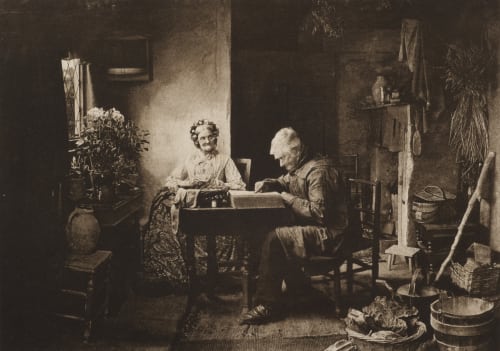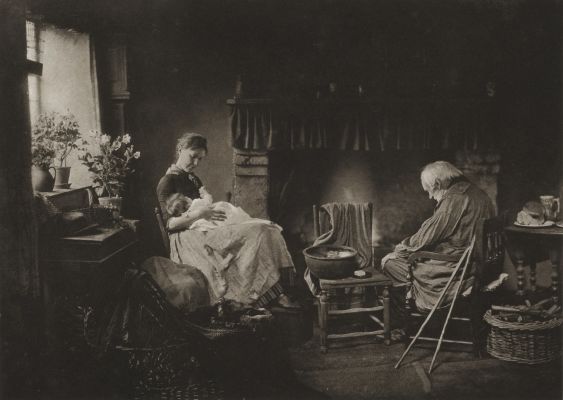
Title
When The Day’s Work Is DoneArtist
Robinson, Henry Peach (British, 1830-1901)Publication
Sun Artists Number 2Date
1890Process
PhotogravureAtelier
Annan & SwanImage Size
12.6 x 18 cm
"One of the best models I ever employed," writes Mr. Robinson, "was an old man of 74. He was a crossing sweeper. I should never have accomplished one of my best works if I had not seen him sitting at a table in my studio, waiting till I could talk to him. I not only saw the old man there, but, mentally, the old lady, the interior of the cottage, although, as it happened, he was sitting before an Italian landscape. The old man, by his attitude and expression, gave the germ of the idea. The old lady had to be found, and the cottage built, but they appeared to me quite visibly and solidly. This was the picture called, ‘When the Day’s Work Is Done ‘ I believe that a great many pictures originate in the same way." —Adams, W. I. Lincoln, In Nature’s Image (New York, 1898) Newhall ‘ In justice to the firm which has produced the photogravures, Messrs. Annan and Swan, it should be explained that the prints are done, not from Mr. Robinson’s negatives, a feat practically impossible, as will easily be understood from the description given of the method by which the purely photographic prints are produced, but from negatives taken from the combination prints produced in Mr. Robinson’s own atelier. [1]
Sun Artists was the first publication in England to represent ‘the artistic position of photography’. Published in eight parts between October 1889 and July 1891, each issue was devoted to the work of a single British photographer and illustrated by four hand-pulled photogravures. Particular care was taken by the publisher of Sun Artists to identify the individuals who prepared the photogravures for publication, all leading exponents of photogravure at the time. Mr Dawson of the Typographic Etching Company, himself an acclaimed photographer, made the etchings for Issue 1. Mr Cameron Swan of Messrs Annan and Swan made those for Issues 2, 3, and 4 while the etchings for Issues 5-8 were made by Mr W.L. Colls. [2]
These exceptional issues highlight those men and women who best express the period’s rich Pictorialist dialogue between painting and photography, the rise of the Secession Movement, and a turning point "in the ways photographs were made for the pages of books" [3] – namely in the photogravure process of "printing photographs from an etched copper plate" -as seen in these 32 superb hand-pulled gravures.
The photographers included are: J. Gale (essay by (George Davison); H.P. Robinson (essay by Andrew Pringle); J.B.B. Wellington (essay by Graham Balfour); Lydell Sawyer (essay by Rev. F.C. Lambert); Julia M. Cameron (essay by P.H. Emerson); B. Gay Wilkinson (essay by Rev. F.C. Lambert); F.W.H. Myers (essay by John Addington Symonds); and Frank Sutcliffe (essay by Charles N. Armfield). Sun Artists was issued in two states, a regular edition and an edition of 100 numbered copies on India proof paper, with the photogravures signed in pencil by the artists, with the exception of Julia Margaret Cameron who had already died.
Reproduced / Exhibited
Newhall, Nancy. P. H. Emerson: The Fight for Photography As a Fine Art. New York: Aperture, 1976. p. 18.
Harker, Margaret F. Victorian and Edwardian Photographs. London: Charles Letts Books Limited, 1982. no. 58.
Gernsheim, Helmut. The History of Photography: The Age of Collodion. London: Thames and Hudson, 1989. p.53
Marien, Mary W. Photography and Its Critics: A Cultural History, 1839-1900. Cambridge: Cambridge University Press, 2011. p. 110
References
[1] Andrew Pringle from the descriptive letterpress.
[2] Hannavy John. 2008. Encyclopedia of Nineteenth-Century Photography. New York NY: Routledge.
[3] Goldschmidt Lucien Weston J Naef and Grolier Club. 1980. The Truthful Lens : A Survey of the Photographically Illustrated Book 1844-1914. 1st ed. New York: Grolier Club no 41
McCaully – History of Photography "Writing Photography’s History before Newhall " v 21 n 2 1997
Harker, Margaret. The Linked Ring: the Secession Movement in Photography in Britain, 1892-1910. London: Heinemann, 1979. Print.
Gernsheim, Helmut. The History of Photography: The Age of Collodion. London: Thames and Hudson, 1989. p.44
Weaver, Mike. British Photography in the Nineteenth Century: The Fine Art Tradition. Cambridge [United States: University Press, 1989. p. 157-8


